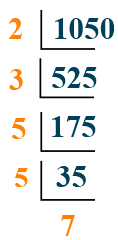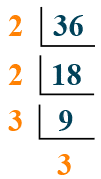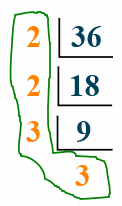
In an earlier blog post, we talked about what prime factorization is and how to use a factor tree to factor numbers to their prime factors.
What if the number you are finding the prime factorization of is a larger number? The factor tree can become quite cumbersome.
Using upside-down division
Another easy way of keeping track of the factorization is to do upside-down division.
Here’s how it works. Let’s start with a smaller number first – say 36.
You start by dividing 36 by 2.

36 divided by 2 is 18.

Then you divide 18 by 2.

18 divided by 2 is 9.

9 divided by 2 does not make a whole number, but divided by 3 it does.

9 divided by 3 is 3.
When completed, the prime factorization is the product of all the numbers around the outside.

2 x 2 x 3 x 3 = 36
Factorizing Larger Numbers
Now, when you try the upside-down division with a larger number, you’ll see how easy this method is.

The answer is: 2 x 3 x 5 x 5 x 7 = 1050.

